|
|
|
Sort Order |
|
|
|
Items / Page
|
|
|
|
|
|
|
| Srl | Item |
| 1 |
ID:
177143
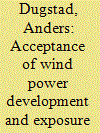

|
|
|
|
|
| Summary/Abstract |
Despite a large stated-preference (SP) literature on wind power externalities, few SP studies employ a case-control approach to examine whether people's acceptance of new wind power developments and renewable energy initiatives increases or decreases with exposure. Furthermore, the existing studies are inconclusive on this issue. In a case-control discrete choice experiment, we measure the level of acceptance in terms of people's willingness-to-accept (WTA) for having future land-based wind power developments in Norway; comparing exposed and non-exposed people's WTA. We find that exposure lowers acceptance. Furthermore, exposed people are also unwilling to pay as much to increase general domestic renewable energy production (from all sources) as non-exposed people, and thus have lower acceptance for such renewable energy policy initiatives. After testing for type of exposure, we argue that the inconclusiveness in the literature of how exposure affects acceptance of wind power developments could be due to the fact that impacts considered differ somewhat across studies.
|
|
|
|
|
|
|
|
|
|
|
|
|
|
|
|
| 2 |
ID:
150031


|
|
|
|
|
| Summary/Abstract |
In this paper, we identify and analyze parameters that determine the profitability of wind power operators in the German market premium model. Based on an empirical analysis of different German wind power profiles from 2007 to mid-2012, we are able to show that the profitability significantly depends on the correlation of the wind power portfolio with the overall wind power feed-in and prediction error in Germany. Significant differences between the wind forecast errors clearing cost of the analyzed portfolios can be identified. Our analysis shows that a wind power operator would profit in most cases from a reduced forecast error, which could be achieved through an improved forecast model and an increased share of the intraday cleared error. Furthermore significant locational portfolio advantages and disadvantages can be identified when comparing the different market values. In general, the empirical analysis shows that a premium of 3.5 €/MWh is suitable to cover the cost of an imperfect forecast. Taking further into account that for 2012 a premium of 12 €/MWh was granted; the direct marketing option can be evaluated as highly attractive, which is furthermore indicated by the rapid increase of the directly marketed wind power and photovoltaic generation.
|
|
|
|
|
|
|
|
|
|
|
|
|
|
|
|
| 3 |
ID:
124307
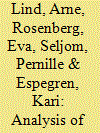

|
|
|
|
|
| Publication |
2013.
|
| Summary/Abstract |
The EU renewable energy (RES) directive sets a target of increasing the share of renewable energy used in the EU to 20% by 2020. The Norwegian goal for the share of renewable energy in 2020 is 67.5%, an increase from 60.1% in 2005. The Norwegian power production is almost solely based on renewable resources and the possibility to change from fossil power plants to renewable power production is almost non-existing. Therefore other measures have to be taken to fulfil the RES directive. Possible ways for Norway to reach its target for 2020 are analysed with a technology-rich, bottom-up energy system model (TIMES-Norway). This new model is developed with a high time resolution among others to be able to analyse intermittent power production. Model results indicate that the RES target can be achieved with a diversity of options including investments in hydropower, wind power, high-voltage power lines for export, various heat pump technologies, energy efficiency measures and increased use of biodiesel in the transportation sector. Hence, it is optimal to invest in a portfolio of technology choices in order to satisfy the RES directive, and not one single technology in one energy sector.
|
|
|
|
|
|
|
|
|
|
|
|
|
|
|
|
| 4 |
ID:
126568


|
|
|
|
|
| Publication |
2013.
|
| Summary/Abstract |
Despite numerous researchers having investigating the development of wind power, the correlation between the elements influencing wind power development has often been ignored. Hence, this research hopes to incorporate both structural equation model (SEM) and fuzzy cognitive map (FCM) to identify a mutual relationship between the various elements, so as to provide feasible recommendations for management strategies. Initially, SEM is used for identification of correlation between the elements and indicating their direction and strength. A standardized causal coefficient from SEM was then used to create an FCM illustrating the effect of the status of one component on the status of another component. The research results pointed out that "policy" would be the major challenge faced by wind power development, as well as the main cause for other obstructions. Therefore, under the objective of maximizing economic benefits, short-term strategies can adopt suitable measures for the two dimensions of "technology" and "environment"; and while mid-term strategies must consider the indirect influences from "social" dimension, long-term strategies must work on "policy".
|
|
|
|
|
|
|
|
|
|
|
|
|
|
|
|
| 5 |
ID:
110744
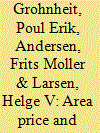

|
|
|
|
|
| Publication |
2011.
|
| Summary/Abstract |
Denmark, east and west of the Great Belt are bidding areas with separate hourly area prices for the Nord Pool power exchange, covering four Nordic countries and parts of Germany. The share of wind power has now increased to 25% on an annual basis in western Denmark. This has a significant impact not only on the electricity wholesale prices, but also on the development of the market. Hourly market data are available from the website of Danish TSO from 1999. In this paper these data are analysed for the period 2004-2010. Electricity generators and customers may respond to hourly price variations, which can improve market efficiency, and a welfare gain is obtained. An important limitation for demand response is events of several consecutive hours with extreme values. The analysis in this paper is a summary and update of some of the issues covered by the EU RESPOND project. It shows that extreme events were few, and the current infrastructure and market organisation have been able to handle the amount of wind power installed so far. This recommends that geographical bidding area for the wholesale electricity market reflects external transmission constraints caused by wind power.
|
|
|
|
|
|
|
|
|
|
|
|
|
|
|
|
| 6 |
ID:
103441
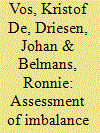

|
|
|
|
|
| Publication |
2011.
|
| Summary/Abstract |
This article deals with a specific support mechanism exempting offshore wind power generators partially from their balancing responsibilities by means of a tolerance margin. This specific support mechanism was enforced in Belgium as from 2009 and is defended by its proponents in view of the lower power output predictability at offshore locations. Although policies accommodating offshore developments may be seen as important to tap better wind resources, this contribution stresses the importance of full balancing responsibility for variable renewables. After a detailed evaluation of the support mechanism and its impact on the balancing costs for wind power generators, the use of current applied production support mechanisms is recommended. These can be used to acquire the same financial effect without increasing market complexity and harming the operation of the balancing market. The first part of the study deals with the specific implementation of the tolerance margin in the Belgian context. Secondly, its underlying motivation is quantitatively assessed, namely the relatively higher offshore prediction errors. Finally, the total offshore subsidy resulting from the measure is determined. Expressed in €/MWh, this subsidy is currently determined at €1.4-1.7/MWh, which represents the required increase of production support in order to replace the regulation.
|
|
|
|
|
|
|
|
|
|
|
|
|
|
|
|
| 7 |
ID:
169730
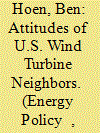

|
|
|
|
|
| Summary/Abstract |
Experts predict continuing deployment of wind turbines in the United States, which will create more interactions between turbines and surrounding communities. Policymakers can benefit from analyses of existing wind projects that enable them to better understand likely effects on residents around proposed projects. Our analysis of a randomly drawn, representative national survey of 1705 existing U.S. wind project neighbors provides previously unavailable detail about factors influencing the attitudes of these neighbors toward their local wind projects. Overall, we find positive-leaning attitudes, which improve over time as individuals self-select into communities near existing wind projects. Hearing wind turbines leads to less-positive attitudes, although living very near to turbines does not, nor does seeing wind turbines. In fact, our findings suggest complex relationships among nearby residents’ attitudes, their perceptions about the particular fit of turbines within their landscape and community, and their perceptions of wind project impacts on property values. These findings—along with the positive correlation between perceived planning-process fairness and attitude—suggest areas of focus for wind project development that may influence social outcomes and acceptance of wind energy. The concluding discussion provides a number of policy and future research recommendations based on the research.
|
|
|
|
|
|
|
|
|
|
|
|
|
|
|
|
| 8 |
ID:
094842
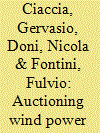

|
|
|
|
|
| Publication |
2010.
|
| Summary/Abstract |
In this work, we propose an index that allows a public authority to order different projects for the construction of onshore wind energy plants and that explicitly takes into account their environmental quality. Wind farm projects are defined as vectors of four attributes: the technical properties of each project, its social impact, its environmental impact, and the share of earnings that proponents offer to the collectivity in compensation for the negative externalities of the wind plant. We define an absolute index that allows the ordering of different proposals and evaluation of the acceptability of each project, providing the monetary value of each point and inducing a truthful revelation of firms' private information. Moreover, we calibrate the index on the basis of data referring to wind plants in Southern Italy and derive the corresponding iso-scoring curves.
|
|
|
|
|
|
|
|
|
|
|
|
|
|
|
|
| 9 |
ID:
166354
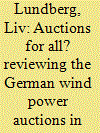

|
|
|
|
|
| Summary/Abstract |
In 2017, Germany introduced auctions to determine the support level for onshore wind power. To protect small-scale actors, citizens’ energy cooperatives were allowed longer realization periods and did not need to have an approval pursuant to the Federal Immission Control Act to submit a bid. Winning cooperatives were given the highest accepted bid, while other participants were paid-as-bid. The aim of this paper is to examine how this auction design affected actor diversity and the risk of winning projects not being realized. Unexpectedly, the outcome of the auctions was that over 90% of the winners were cooperatives, and the average project size of their bids was twice the size of other winning bids. There was also a significant decrease in the highest accepted bid, from 5.78€ct/kWh in the first auction, to 3.82€ct/kWh in the third auction. However, the pricing rule combined with uncertain technology costs and strong competition, may have encouraged overly aggressive bidding. This, as well as cooperatives being exempt from having an approval pursuant to the Federal Immission Control Act, could increase the risk of winning projects not being realized. A conclusion is that special rules for small-scale actors, should be used with caution, especially if they give significant competitive advantages and may affect realization rates.
|
|
|
|
|
|
|
|
|
|
|
|
|
|
|
|
| 10 |
ID:
118854


|
|
|
|
|
| Publication |
2013.
|
| Summary/Abstract |
The beneficial results of the exponential expansion of photovoltaic installations in Germany and Italy are discussed. Remarkable falls in the peak price of electricity have been observed in both countries. The reasons are discussed in the light of the data from the Kombikraftwerk project. This has demonstrated, in a scaled, real-time experiment, how the demand on the German grid can be met by photovoltaics and wind with back-up from biogas and (pumped hydro) storage. We discuss the implications of the fall in price of photovoltaic cells particularly for 3rd generation technology. Using the specific example of the UK, we demonstrate the advantages of the complementary nature of wind and photovoltaic resources. We demonstrate that the wind and photovoltaic capacity targets for an all renewably powered UK are likely to be significantly lower than in Germany. We conclude by summarising the evidence in favour of a moratorium on all new electricity generation other than by the renewables.
|
|
|
|
|
|
|
|
|
|
|
|
|
|
|
|
| 11 |
ID:
176716
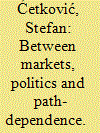

|
|
|
|
|
| Summary/Abstract |
This article contributes to the recent scholarly attempts towards bridging different energy studies perspectives in explaining the change of energy systems. Informed by political, socio-technical and techno-economic perspectives on energy transitions, we focus on explaining the divergent solar and wind power deployment rates across six Central and Eastern European countries. We suggest and test the proposition that the interplay of four key factors has shaped this development: state capacities, relations with Russia, technological lockin and electricity import dependency. We find that the countries relations towards Russia, the level of nuclear power lock-in and the state intervention in the energy sector have been instrumental in affecting the adoption of wind and solar power. The integrated framework and the findings presented in the article should encourage future energy transition research to capture and trace the interplay among different factors in an integrated and comparable manner.
|
|
|
|
|
|
|
|
|
|
|
|
|
|
|
|
| 12 |
ID:
099270
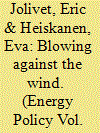

|
|
|
|
|
| Publication |
2010.
|
| Summary/Abstract |
This paper analyses the deployment of wind power and the related local controversies using actor-network theory (ANT). ANT provides conceptual instruments for a fine-tuned analysis of the contingencies that condition a project's success or failure by focusing on the micro-decisions that intertwine the material aspects of the technology, the site where it is implemented, the participation process, and the social relations in which they are embedded. By considering controversies as alternative efforts of competing networks of actors to 'frame' the reality and enroll others, ANT sheds light on the complex and political nature of planning a wind farm project, insofar as it consist in aligning material and human behaviours into a predictable scenario. 'Overflows' occur when actors do not conform to expectations, adopt conflicting positions and develop their own interpretations of the project, thus obliging designers to adapt their frames and change their plans. To demonstrate this framework, we apply it to the case of a wind farm project in the South of France, near Albi. Our analysis suggests a new approach to examining wind power projects in terms of the interaction between globally circulating technologies, unique characteristics of the site, the participation process and the social dynamics that emerge when these are combined.
|
|
|
|
|
|
|
|
|
|
|
|
|
|
|
|
| 13 |
ID:
096732
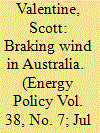

|
|
|
|
|
| Publication |
2010.
|
| Summary/Abstract |
This paper provides a critical evaluation of Australia's new Renewable Energy Target (RET) program with respect to its capacity to support wind power development. Four structural flaws associated with the RET which undermine its effectiveness as a catalyst for technological change in the electricity sector are discussed: (i) the inclusion of waste coal mine gas (WCMG) as an eligible fuel source which acts as an indirect coal industry subsidy, (ii) program duration which is too short and ill-structured, (iii) a multiplier that is well-intended to support small-scale renewable technologies but which creates "phantom capacity", and (iv) the capped target of 45,000 GWh which will stymie long-term wind power market investment. The paper concludes with recommendations which stress the importance of passing effective Carbon Pollution Renewable Scheme (CPRS) legislation to offset the weaknesses associated with the RET. If an effective CPRS cannot be implemented, the paper recommends that amendments be made to the RET to (i) remove WCMG from the list of approved alternative energy sources, and (ii) extend the RET targets to reach 120,000 GWh by 2030.
|
|
|
|
|
|
|
|
|
|
|
|
|
|
|
|
| 14 |
ID:
097532
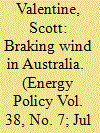

|
|
|
|
|
| Publication |
2010.
|
| Summary/Abstract |
This paper provides a critical evaluation of Australia's new Renewable Energy Target (RET) program with respect to its capacity to support wind power development. Four structural flaws associated with the RET which undermine its effectiveness as a catalyst for technological change in the electricity sector are discussed: (i) the inclusion of waste coal mine gas (WCMG) as an eligible fuel source which acts as an indirect coal industry subsidy, (ii) program duration which is too short and ill-structured, (iii) a multiplier that is well-intended to support small-scale renewable technologies but which creates "phantom capacity", and (iv) the capped target of 45,000 GWh which will stymie long-term wind power market investment. The paper concludes with recommendations which stress the importance of passing effective Carbon Pollution Renewable Scheme (CPRS) legislation to offset the weaknesses associated with the RET. If an effective CPRS cannot be implemented, the paper recommends that amendments be made to the RET to (i) remove WCMG from the list of approved alternative energy sources, and (ii) extend the RET targets to reach 120,000 GWh by 2030.
|
|
|
|
|
|
|
|
|
|
|
|
|
|
|
|
| 15 |
ID:
150767


|
|
|
|
|
| Summary/Abstract |
The European power sector is transforming due to climate policies and an increased deployment of intermittent RES. The sector will require thermal power plants for the decades to come, but their business cases are (negatively) affected by this transformation. This study presents a novel tool to quantify the effect of policy, price and project-related uncertainties on power plant business cases. This tool can support policymakers in stimulating necessary investments in new thermal generation capacity. We find that these investments are currently unsound (power plants recoup on average –12% to 59% of their initial investment). Future climate policy, i.e. the CO2 price, has a very strong impact on business cases (affects the profitability by 5–40%-points). The impact of the deployment of wind power is average (2–8%-point difference between 10% and 21% wind penetration). Variations in annual wind power production barely affect the profitability (variation of ±1%-point). To stimulate new investments, policymakers should first decrease the uncertainty in business cases caused by policy. Durable climate policy is especially important. Also, policies to increase the profits of thermal power plants should be carefully considered and implemented. This combined approach will reduce the revenue gap that needs to be bridged by supportive policies.
|
|
|
|
|
|
|
|
|
|
|
|
|
|
|
|
| 16 |
ID:
191311
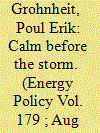

|
|
|
|
|
| Summary/Abstract |
Western Denmark is a separate bidding area in the North-Western European power market, Nord Pool. Wind power now exceeds 50% of production annually in Western Denmark. Hourly market data from 1999 onwards are publicly available from the Danish TSO. In this paper, we analyse these data for 2009–2021. Until the energy crisis began in 2021, the Nordic power market has shown relatively stable prices. While extreme events are moderately increasing, the value factor of wind is stable. Thus, the current infrastructure – flexible power plants, interconnectors and electrification of district heating – and market organisation can manage the amount of wind power installed. In other words: 2009–2021 show a well-functioning market economy of dispatch, operating on top of a planned economy of investment.
|
|
|
|
|
|
|
|
|
|
|
|
|
|
|
|
| 17 |
ID:
094880
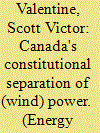

|
|
|
|
|
| Publication |
2010.
|
| Summary/Abstract |
This paper investigates the impact that a federal government structure has on strategic selection of renewable energy policy instruments. The context for this study centers on wind power development in Canada. Canada is a nation that is blessed by all the attributes necessary to catalyze global leadership in installed wind power capacity. Unfortunately, the constitutional separation of powers that underpins Canada's federal system impedes the creation of a national wind power development strategy because Canada's provinces have constitutional authority over electricity governance. The insights gleaned from the case study are used to develop a conceptual framework for understanding the impact that federal structure has on policy instrument selection and efficacy under areas of federal, regional and concurrent policy jurisdiction. Finally, this framework is re-applied to identify specific approaches the Canadian federal government could take to resolve what currently amounts to be a fragmented, ineffective approach to wind power development planning.
|
|
|
|
|
|
|
|
|
|
|
|
|
|
|
|
| 18 |
ID:
166335
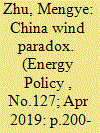

|
|
|
|
|
| Summary/Abstract |
China has seen a surge in wind power installation over the past decade, and is now the world leader in installed capacity. However, wind curtailment – i.e., when the power grid frequently interrupts the power connection of installed wind capacity – has become an increasingly serious problem. But despite wind curtailment significantly jeopardizing wind power developers’ profitability in China, companies have continued to invest. This study, based on extensive interviews with decision-makers in China's Central State-Owned Enterprises (CSOEs), attempts to explain this seeming paradox. Since the majority of wind power investment in China has been made by CSOEs, previous findings of SOE studies assume that this continued investment abjures “economic rationality” due to political/policy burdens. However, this study shows that this is not necessarily accurate. CSOEs’ investment behavior also accords with market logic, as they competed fiercely over wind power sites, increasing investment scale as a rational long-term strategy of profitability. We also find that the embrace of market logic by CSOEs has resulted from recent economic and power sector reforms. For a more efficient market, policy-makers must pay greater attention to the quality of competition among CSOEs.
|
|
|
|
|
|
|
|
|
|
|
|
|
|
|
|
| 19 |
ID:
146674
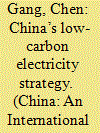

|
|
|
|
|
| Contents |
With a carbon-constrained new normal that emissions of greenhouse gases can no longer be assumed to be costless, non-fossil fuels including hydro, nuclear, wind and solar power have witnessed fast growth in both production and consumption in China. In promoting the production of different low-carbon alternatives, the Chinese government has been adjusting its policy prioritisation from time to time in targeted growth scopes, subsidy amount, on-grid tariffs and other financial incentives for various low-carbon power sectors. China’s Five-Year Plans have been playing a vital role in engendering fierce competition within the low-carbon energy sector. Other variables, like adjustment of electricity tariffs, inherent geographical and meteorological advantages related to certain types of power generation, domestic supporting industries, technological competitiveness and environmental concerns, have also helped to reshape the low-carbon power market.
|
|
|
|
|
|
|
|
|
|
|
|
|
|
|
|
| 20 |
ID:
118109
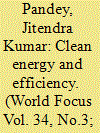

|
|
|
|
|
|
|
|